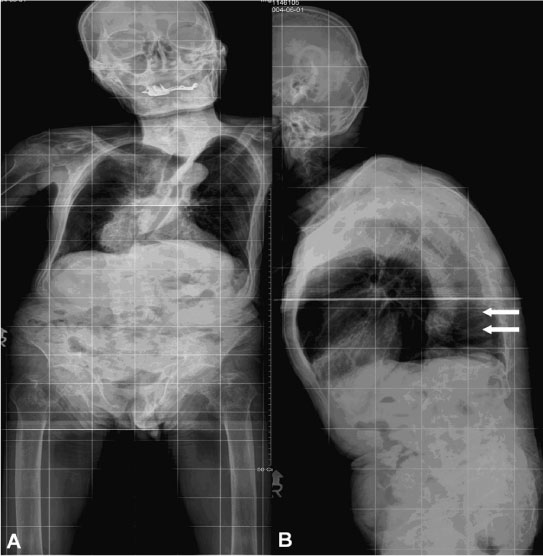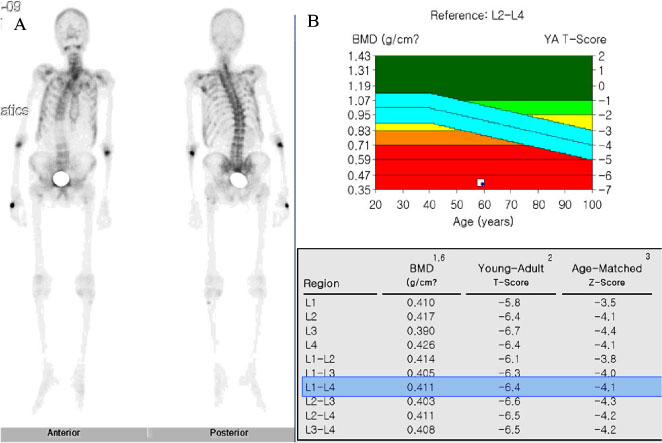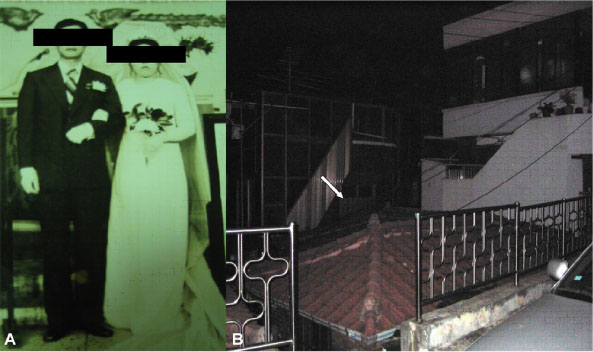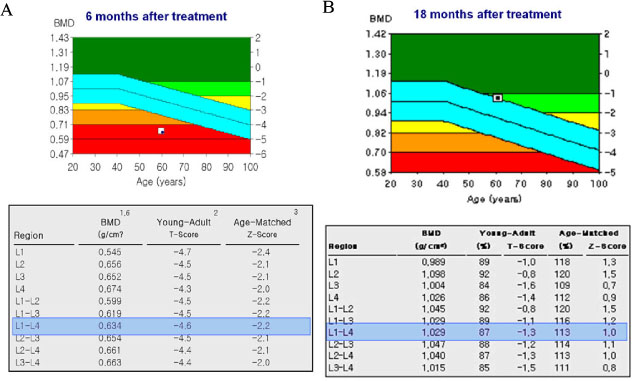J Korean Endocr Soc.
2007 Feb;22(1):55-61. 10.3803/jkes.2007.22.1.55.
A Case of Osteomalacia Caused by Severe Vitamin D Deficiency
- Affiliations
-
- 1Department of Endocrinology and Metabolism, Kyung Hee University, Korea.
- 2Department of College of Medicine, Research Institute of Endocrinology, Kyung Hee University, Korea.
- 3Department of Nuclear Medicine, Kyung Hee University, Korea.
- KMID: 2178243
- DOI: http://doi.org/10.3803/jkes.2007.22.1.55
Abstract
- Vitamin D is a kind of hormone that can be synthesized in the skin or it is supplied in the diet it is involved in a central role in bone and calcium homeostasis in vivo. Metabolic bone diseases such as rickets in children and osteomalacia in adults can also be caused by deficiency or metabolic defects in the vitamin D hormone related system. However, there has been a lack of generalized epidemiologic studies about the vitamin D deficiency status in Koreans. We recently experienced a case of osteomalacia caused by severe vitamin D deficiency. These kinds of case have not been reported elsewhere in Korea for the last twenty years.
Keyword
MeSH Terms
Figure
Cited by 1 articles
-
A Case of Nutritional Osteomalacia in Young Adult Male
Choong-Kyun Noh, Min-Jeong Lee, Bu Kyung Kim, Yoon-Sok Chung
J Bone Metab. 2013;20(1):51-55. doi: 10.11005/jbm.2013.20.1.51.
Reference
-
1. Kasper DL, Harrison TR. Harrison's principles of internal medicine. 2005. 16th ed. New York: McGraw-Hill;2246.2. Cecil RL, Goldman L, Ausiello DA. Cecil textbook of medicine. 2004. 22nd ed. Philadelphia: Saunders;1545.3. Holick MF. McCollum Award Lecture, 1994: vitamin D-new horizons for the 21st century. Am J Clin Nutr. 1994. 60:619–630.4. Garland CF, Garland FC, Gorham ED. Calcium and vitamin D. Their potential roles in colon and breast cancer prevention. Ann N Y Acad Sci. 1999. 889:107–119.5. Williams RH, Larsen PR. Williams textbook of endocrinology. 2003. 10th ed. Philadelphia: Saunders;1344–1346.6. Webb AR, Kline L, Holick MF. Influence of season and latitude on the cutaneous synthesis of vitamin D3: exposure to winter sunlight in Boston and Edmonton will not promote vitamin D3 synthesis in human skin. J Clin Endocrinol Metab. 1988. 67:373–378.7. Chapuy MC, Preziosi P, Maamer M, Arnaud S, Galan P, Hercberg S, Meunier PJ. Prevalence of vitamin D insufficiency in an adult normal population. Osteoporos Int. 1997. 7:439–443.8. Park HM, Kim JG, Choi WH, Lim SK, Kim GS. The Vitamin D Nutritional Status of Postmenopausal Women in Korea. Kor J Bone Metab. 2003. 10:47–55.9. Dawson-Hughes B, Heaney RP, Holick MF, Lips P, Meunier PJ, Vieth R. Estimates of optimal vitamin D status. Osteoporos Int. 2005. 16:713–716.10. McKenna MJ. Differences in vitamin D status between countries in young adults and the elderly. Am J Med. 1992. 93:69–77.11. van der Wielen RP, Lowik MR, van den Berg H, de Groot LC, Haller J, Moreiras O, van Staveren WA. Serum vitamin D concentrations among elderly people in Europe. Lancet. 1995. 346:207–210.12. Song YD, Jung YS, Lim SK, Chung CH, Lee EJ, Kim KR, Lee HC, Huh KB, Yoon JY, Park EZ, Lee JH. Seasonal variation in serum 25-hydroxyvitamin D in the elderly in Korean. J Kor Soc Endocrinol. 1994. 9:121–127.13. Vieth R, Ladak Y, Walfish PG. Age-related changes in the 25-hydroxyvitamin D versus parathyroid hormone relationship suggest a different reason why older adults require more vitamin D. J Clin Endocrinol Metab. 2003. 88:185–191.14. Lo CW, Paris PW, Holick MF. Indian and akistani immigrants have the same capacityas Caucasians to produce vitamin D in response to ultraviolet irradiation. Am J Clin Nutr. 1986. 44:683–685.15. Kim H, Ku SY, Kim SH, Choi YM, Moon SY, Kim JG. A Study on vitamin D insufficiency in postmenopausal Korean women. Kor Soc Osteoporosis. 2003. 1:12–21.16. Rhee Y, Lee HJ, Kim YM, Lee SH, Ahn CW, Cha BS, Kim KR, Lee HC, Lim S-K. The status of the serum 25-hydroxyvitamin D level in Korean postmenopausal women and its effect on bone metabolism. Kor Soc Osteoporosis. 2003. 1:22–30.17. Rizzoli R, Eisman JA, Norquist J, Ljunggren O, Krishnarajah G, Lim SK, Chandler J. Risk factors for vitamin D inadequacy among women with osteoporosis: an international epidemiological study. Int J Clin Pract. 2006. 60:1013–1019.18. Lips P, Hosking D, Lippuner K, Norquist JM, Wehren L, Maalouf G, Ragi-Eis S, Chandler J. The prevalence of vitamin D inadequacy amongst women with osteoporosis: an international epidemiological investigation. J Intern Med. 2006. 260:245–254.19. Marriott BM. Vitamin D supplementation: a word of caution. Ann Intern Med. 1997. 127:231–233.20. Salih FM. Effect of clothing varieties on solar photosynthesis of previtamin D3: an in vitro study. Photodermatol Photoimmunol Photomed. 2004. 20:53–58.
- Full Text Links
- Actions
-
Cited
- CITED
-
- Close
- Share
- Similar articles
-
- A Case of Nutritional Osteomalacia in Young Adult Male
- Atraumatic Bilateral Fracture of the Femoral Neck in Young Male Patient with Suspected Osteomalacia
- Osteomalacia and myelofibrosis as a manifestation of vitamin D deficiency
- A case of osteomalacia due to vitamin D deficiency in a 36-year-old woman
- Dilated Cardiomyopathy in a 2 Month-Old Infant: A Severe Form of Hypocalcemia With Vitamin D Deficient Rickets





